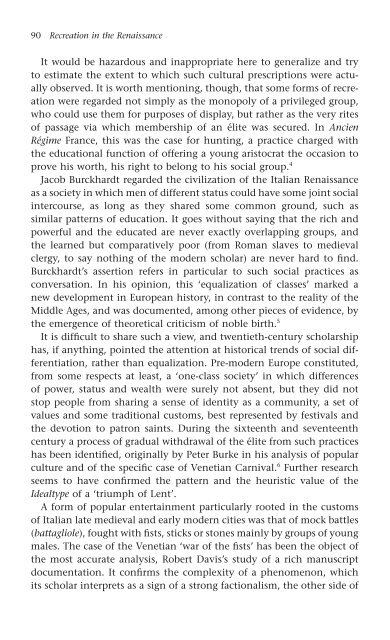Recreation in the Renaissance
Recreation in the Renaissance
Recreation in the Renaissance
- No tags were found...
You also want an ePaper? Increase the reach of your titles
YUMPU automatically turns print PDFs into web optimized ePapers that Google loves.
90 <strong>Recreation</strong> <strong>in</strong> <strong>the</strong> <strong>Renaissance</strong><br />
It would be hazardous and <strong>in</strong>appropriate here to generalize and try<br />
to estimate <strong>the</strong> extent to which such cultural prescriptions were actually<br />
observed. It is worth mention<strong>in</strong>g, though, that some forms of recreation<br />
were regarded not simply as <strong>the</strong> monopoly of a privileged group,<br />
who could use <strong>the</strong>m for purposes of display, but ra<strong>the</strong>r as <strong>the</strong> very rites<br />
of passage via which membership of an élite was secured. In Ancien<br />
Régime France, this was <strong>the</strong> case for hunt<strong>in</strong>g, a practice charged with<br />
<strong>the</strong> educational function of offer<strong>in</strong>g a young aristocrat <strong>the</strong> occasion to<br />
prove his worth, his right to belong to his social group. 4<br />
Jacob Burckhardt regarded <strong>the</strong> civilization of <strong>the</strong> Italian <strong>Renaissance</strong><br />
as a society <strong>in</strong> which men of different status could have some jo<strong>in</strong>t social<br />
<strong>in</strong>tercourse, as long as <strong>the</strong>y shared some common ground, such as<br />
similar patterns of education. It goes without say<strong>in</strong>g that <strong>the</strong> rich and<br />
powerful and <strong>the</strong> educated are never exactly overlapp<strong>in</strong>g groups, and<br />
<strong>the</strong> learned but comparatively poor (from Roman slaves to medieval<br />
clergy, to say noth<strong>in</strong>g of <strong>the</strong> modern scholar) are never hard to f<strong>in</strong>d.<br />
Burckhardt’s assertion refers <strong>in</strong> particular to such social practices as<br />
conversation. In his op<strong>in</strong>ion, this ‘equalization of classes’ marked a<br />
new development <strong>in</strong> European history, <strong>in</strong> contrast to <strong>the</strong> reality of <strong>the</strong><br />
Middle Ages, and was documented, among o<strong>the</strong>r pieces of evidence, by<br />
<strong>the</strong> emergence of <strong>the</strong>oretical criticism of noble birth. 5<br />
It is difficult to share such a view, and twentieth-century scholarship<br />
has, if anyth<strong>in</strong>g, po<strong>in</strong>ted <strong>the</strong> attention at historical trends of social differentiation,<br />
ra<strong>the</strong>r than equalization. Pre-modern Europe constituted,<br />
from some respects at least, a ‘one-class society’ <strong>in</strong> which differences<br />
of power, status and wealth were surely not absent, but <strong>the</strong>y did not<br />
stop people from shar<strong>in</strong>g a sense of identity as a community, a set of<br />
values and some traditional customs, best represented by festivals and<br />
<strong>the</strong> devotion to patron sa<strong>in</strong>ts. Dur<strong>in</strong>g <strong>the</strong> sixteenth and seventeenth<br />
century a process of gradual withdrawal of <strong>the</strong> élite from such practices<br />
has been identified, orig<strong>in</strong>ally by Peter Burke <strong>in</strong> his analysis of popular<br />
culture and of <strong>the</strong> specific case of Venetian Carnival. 6 Fur<strong>the</strong>r research<br />
seems to have confirmed <strong>the</strong> pattern and <strong>the</strong> heuristic value of <strong>the</strong><br />
Idealtype of a ‘triumph of Lent’.<br />
A form of popular enterta<strong>in</strong>ment particularly rooted <strong>in</strong> <strong>the</strong> customs<br />
of Italian late medieval and early modern cities was that of mock battles<br />
(battagliole), fought with fists, sticks or stones ma<strong>in</strong>ly by groups of young<br />
males. The case of <strong>the</strong> Venetian ‘war of <strong>the</strong> fists’ has been <strong>the</strong> object of<br />
<strong>the</strong> most accurate analysis, Robert Davis’s study of a rich manuscript<br />
documentation. It confirms <strong>the</strong> complexity of a phenomenon, which<br />
its scholar <strong>in</strong>terprets as a sign of a strong factionalism, <strong>the</strong> o<strong>the</strong>r side of










